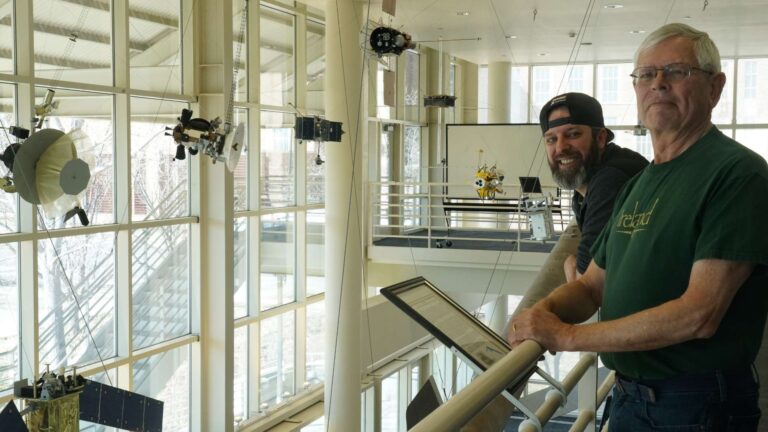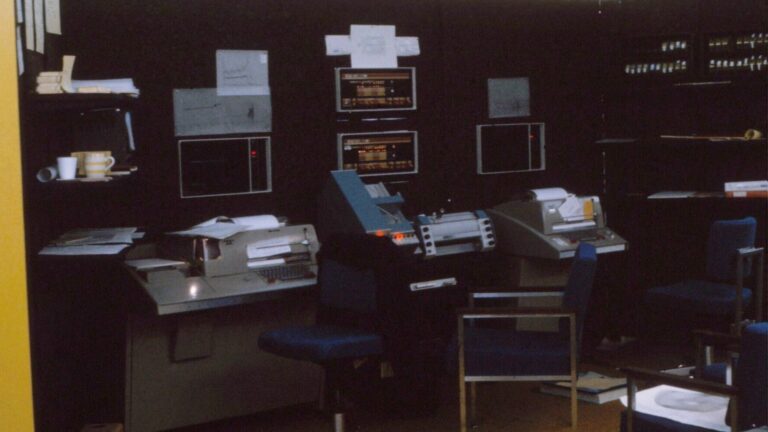Following a four-decade-long career building the IT infrastructure at LASP, Phil Evans has continued his passion for space by building model spacecraft to share with the CU Boulder community. His son Brian Evans is carrying on the family tradition with a career in IT at LASP.

In 1969, Phil Evans was studying aerospace and electrical engineering at CU Boulder when a mentor asked him if he wanted a job working with the new computers over at the Laboratory for Atmospheric and Space Physics. The question would change the course of his career, as well as his son’s. Evans said yes, and went on to work for the laboratory—building and supporting the thousands of computers, servers, and networks that enabled innovation and exploration during 80 space missions—for the next 41 years, until his retirement in 2010.
“I was about 9 years old when Sputnik was launched, and I told my parents that I wanted to have something to do with the Space Program,” Evans said. “I don’t know of anywhere else besides LASP that I could have had more involvement.”
That involvement continues today with the legacy of the information technology infrastructure he left the lab, along with the nearly two dozen, highly detailed model spacecraft he built, which are on display in the lobby of the LASP Space Technology Building (LSTB).
Mariner 9: A Computing Challenge
When Evans started working at LASP, the lab had just acquired its second computer, which had just 32K of memory and filled an entire cabinet. LASP’s first computer was a PDP-8, a room-sized computer with 12K of memory, Evans said.
During his career he supported more than 1,700 computers representing about 450 different types, from DEC PDPs and VAXes to Sun Sparcstations, SunBlades, and Ultras, and from Apple Macintoshs, PowerMacs, and PowerBooks, to Gateway, Dell, HP, IBM Windows PCs and many others. “I don’t think I ever had a day that I didn’t look forward to coming to work,” Evans said.

One of the biggest computing challenges Evans faced during that time occurred during the Mariner 9 mission, which launched in May 1971 and became the first spacecraft to orbit another planet. The spacecraft was already on its way to Mars when the team was faced with building a system to receive and analyze the data it would send back when it got there. The innovative solution entailed building an interface for the downlink computer that resembled the memory of another computer so the two could talk to each other. “Today, you can just plug two computers together, but you couldn’t do that back then,” Evans said.
The solution Evans and his team devised allowed the analysis of the Mariner 9 data, including more than 7,000 high-quality images of the surface of Mars. These included the first detailed views of Olympus Mons, the solar system’s largest volcano, and Valles Marineris, a canyon system larger than the Grand Canyon. Mariner 9 also captured the first closeup pictures of the Martian moons, Phobos and Deimos.
During Evans’ career at LASP, he became one of just a handful of employees—along with Flight Software Group Manager Mark Lankton, Associate Director of Mission Operations Randy Davis, and Senior Professional Research Assistant Karen Simmons—to have worked on missions that visited the Sun and every planet in the solar system: “Even Pluto, back when it was still a planet.”
Scaling Down Space
In the late 1970s, Evans discovered a passion for model-making. Given his interest in space science and the burgeoning Space Race, he decided to start building small-scale versions of spacecraft, many of which LASP had some role in.
Beginning with the Voyager missions in 1977, Evans sought to accurately depict spacecraft using balsa wood, plastic, tiny bits of wire and tubing, and other supplies available in craft and hardware stores. “Plus super glue,” he said. “Lots of super glue.”
The first model he built was Voyager 1, which he scaled down to 1/25th its true size. After it was completed, however, he said he realized that was too small. He settled on 1/10th scale for all the models since. Evans even went to the effort to make another Voyager 1 model—at 1/10th scale—which now hangs above the LSTB entryway next to the Hubble Space Telescope model. Evans said that Hubble was one of the most challenging models to build, due to the large solar panels, telescope, and mirrors.

Each of Evans’ models exhibits his dedication to detail and accuracy. For example, many illustrations of the Galileo spacecraft, launched in 1989 on a mission to Jupiter, render a fully deployed umbrella-shaped high-gain antenna. But that’s not how it ever appeared in space.
After the first Earth flyby, at least three of the spars on Galileo’s antenna failed to deploy. However, thanks to Evans’ realistic model, from a vantage point on the LSTB second-floor walkway, you can see what that might have looked like. The story is included in the mission highlights, which were written by Evans and displayed near each model.
A Family Tradition
Each model took anywhere from a month to a year-and-a-half to build, Evans said, depending on how busy life was at the time. He and his wife raised their two sons, Brian and Neal, in Boulder, where both became Eagle Scouts. In 2004, his son Brian continued the family tradition and came to work for LASP, where he is now technical lead of the Information Technology Helpdesk. Neal also worked at LASP one summer.
Today, with supply-chain issues, it’s sometimes hard to get parts. In the past, though, Evans has shown that he can improvise when needed. Visitors to the LSTB lobby who look closely at the dish antennas of many of the spacecraft models might recognize a familiar household item: bowl-shaped light fixtures. The interior of the Hubble model’s telescope is ingeniously supported by pieces of laminate kitchen countertop.
Evans is now working on a model of the Geostationary Operational Environmental Satellite (GOES); it will be his 21st. When it’s complete, he’ll ask his son Brian to help him hang it from the ceiling of LSTB, continuing his legacy and another family tradition.
-Written by Sara Pratt, LASP Senior Communications Specialist
Founded a decade before NASA, the Laboratory for Atmospheric and Space Physics at the University of Colorado Boulder is on a mission to transform human understanding of the cosmos by pioneering new technologies and approaches to space science. LASP is the only academic research institute in the world to have sent instruments to every planet in our solar system. LASP began celebrating its 75th anniversary in April 2023.



